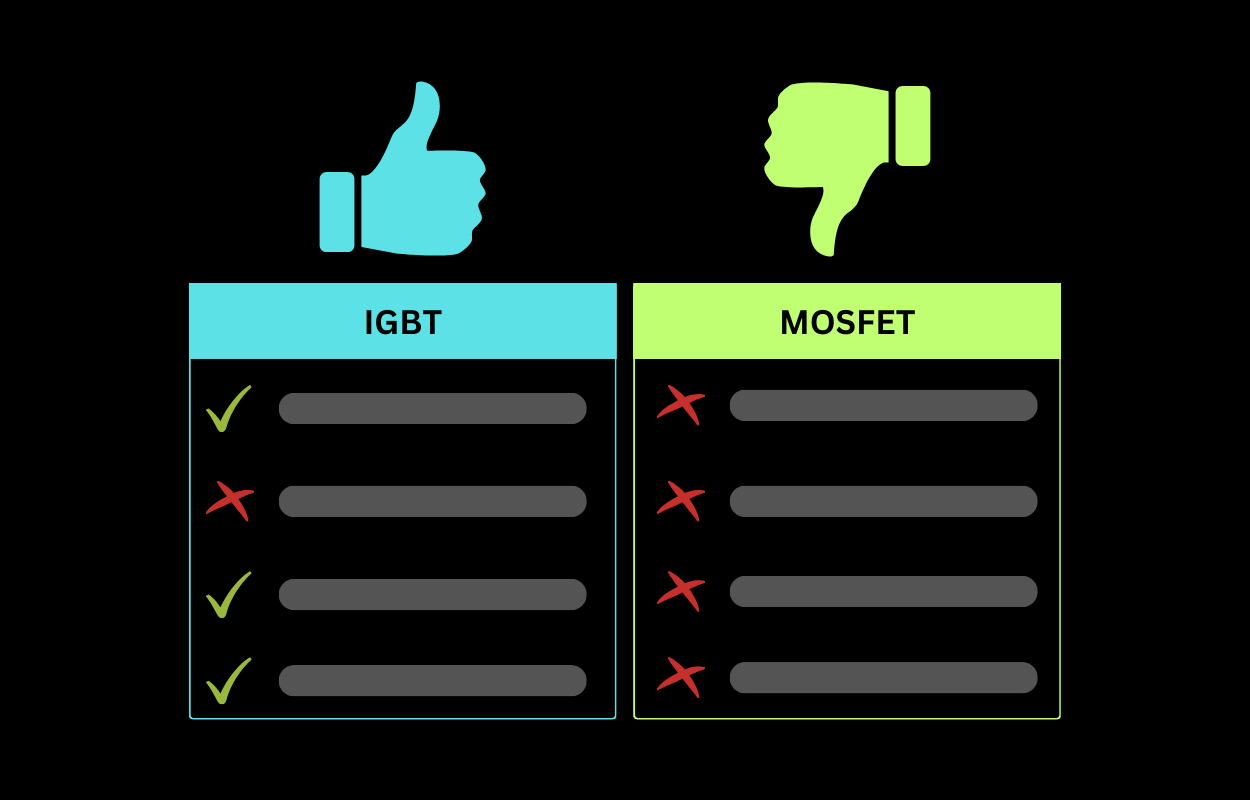Insulated Gate Bipolar Transistor (IGBT) and Metal-Oxide-Semiconductor Field-Effect Transistor (MOSFET) are both types of transistors used in electronic devices and power electronics. Each has its own set of advantages and disadvantages. Here are some advantages of IGBTs over MOSFETs in certain applications:
- Switching Speed: IGBTs generally have a lower switching frequency compared to MOSFETs. This can be advantageous in certain applications where high-speed switching is not a critical requirement. The slower switching speed can reduce switching losses and improve overall efficiency in certain power electronics applications.
- Drive Voltage: IGBTs typically require a lower gate drive voltage compared to high-power MOSFETs. This can simplify the gate drive circuitry and reduce the overall system complexity.
- Conduction Losses: IGBTs have lower conduction losses than MOSFETs in high-voltage applications. This is because IGBTs have a voltage drop across the collector-emitter junction similar to a bipolar junction transistor (BJT), which tends to be lower than the on-state voltage drop of a MOSFET.
- Overcurrent Handling: IGBTs are generally more rugged and can handle higher overcurrent conditions without sustaining damage compared to MOSFETs. This makes IGBTs suitable for certain applications where robustness is a critical factor.
- Parallel Operation: IGBTs are easier to parallel in high-power applications compared to MOSFETs. Parallel operation allows for sharing the load current among multiple devices, improving reliability and overall system performance.
- Cost: In certain voltage and current ranges, IGBTs may be more cost-effective than MOSFETs. This cost advantage can be a significant factor in choosing between the two technologies for specific applications.
Advantages of IGBT over MOSFET
Here is the igbt and mosfet difference table:
| Advantage | Explanation |
|---|---|
| Switching Speed | IGBTs generally have a lower switching frequency, reducing switching losses in certain applications. |
| Drive Voltage | IGBTs typically require a lower gate drive voltage, simplifying gate drive circuitry. |
| Conduction Losses | IGBTs have lower conduction losses in high-voltage applications due to lower on-state voltage drop. |
| Overcurrent Handling | IGBTs are more rugged and can handle higher overcurrent conditions without damage. |
| Parallel Operation | IGBTs are easier to parallel, allowing for improved reliability and load sharing. |
| Cost | In certain voltage and current ranges, IGBTs may be more cost-effective than MOSFETs. |
It’s important to note that the choice between IGBTs and MOSFETs depends on the specific requirements of the application. MOSFETs are often preferred in high-frequency and high-speed applications due to their faster switching speeds, while IGBTs are favored in high-voltage and high-power applications where their characteristics provide certain advantages.
IGBT vs MOSFET
IGBTs and MOSFETs are like tools for different jobs in electronics:
- IGBTs are great for slower jobs (less than 20,000 times per second) where they need to handle a lot of stress.
- MOSFETs are better for faster jobs (more than 20,000 times per second) in some cases.
- MOSFETs can handle smaller tasks, but IGBTs are better for certain types of tasks that need soft-switching and handling lots of power. Think of it like using the right tool for the right job!
FAQ: Advantages of IGBT over MOSFET
Why igbt is better than mosfet
IGBTs are like superheroes in some jobs compared to MOSFETs. They’re better at saving energy in high-voltage situations, tough enough to handle too much power without getting hurt, and can work together easily. Plus, they’re budget-friendly in certain situations. But remember, choosing between them depends on the job—they each have their own superpowers for different situations!
